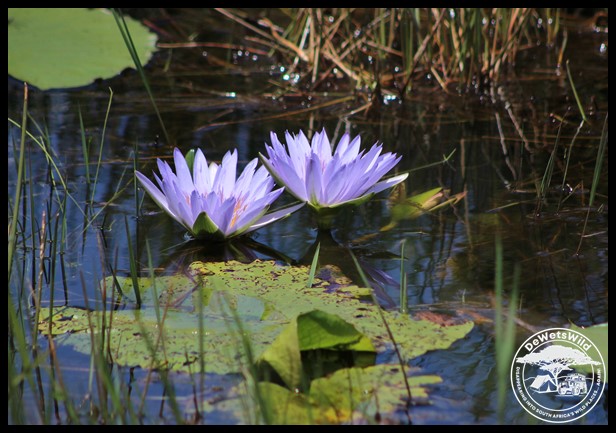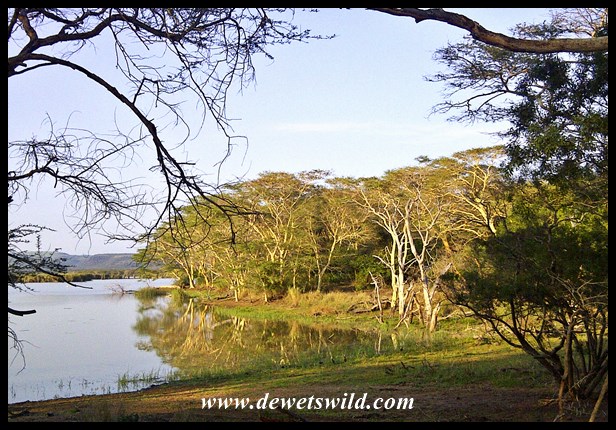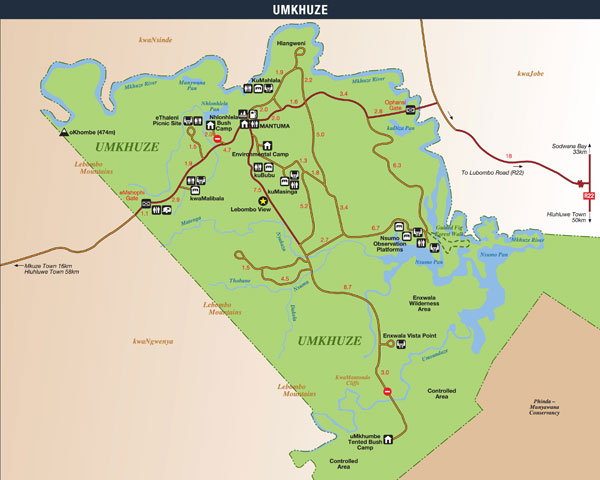Join us for a look back at the wonderfully wild South African destinations we visited during 2023. May 2024 be a blessed year for you and your family, memorable for all the best reasons.



Join us for a look back at the wonderfully wild South African destinations we visited during 2023. May 2024 be a blessed year for you and your family, memorable for all the best reasons.

As befits a conservation area of its stature, the iSimangaliso Wetland Park is extremely rich in fauna of all description. In this final post about our recent tour of the reserve I’ll be sharing some more of the wonderful animal sightings we had.
The tropical environment of northern Kwazulu-Natal is home to some very interesting invertebrate creatures – the Flatface Longhorn Beetle I showed you a few days ago being a fantastic example.
Fish and frogs must be finding the wet conditions prevailing now after suffering through a terrible drought not so long ago very much to their liking!
Even though most of them are shy and seldomly seen, iSimangaliso is home to an amazing array of reptiles as well – many of them rather dangerous!
We dedicated an entire post to the amazing diversity of birds that we found in iSimangaliso during our most recent trip.
Mammals are well represented at iSimangaliso, and zebras, giraffes, warthogs, various kinds of antelope and primates are regularly encountered along the routes traversing the Park.
Sitting outside watching our fire one evening at Mantuma Camp in the uMkhuze Game Reserve we were joined by a large herd of impalas and nyalas.
These Kudu bulls decided to have it out right in the middle of the road between St. Lucia and Cape Vidal.
While traveling along the grassland loop through the Eastern Shores section of the Park we came across a group of hyenas finishing off the remains of a buffalo.
At the other end of the scale are Africa’s grey behemoths, all of which are found at iSimangaliso. Without forgetting to mention the Humpback Whales and dolphins so often seen just offshore, I’ve also already given closer attention to elephants and buffaloes. Hippos were one of the main reasons for the establishment of the St. Lucia Game Reserve 128 years ago, and they are still very much in evidence. We also encountered White and Black Rhinos, but I won’t be sharing photo’s of them as they were in some easily recognisable spots.
Remember that DeWetsWild will gladly assist you with reservations and guided tours of the iSimangaliso Wetland Park if you’d like to visit this wonderful place as well.

More than 500 bird species have been recorded within the borders of the iSimangaliso Wetland Park, making it one of the country’s most rewarding bird-watching destinations – a fact that was once again proven to be undeniable during my latest tour of “The Place of Miracles and Wonders”. Even if I hadn’t ticked the Lesser Moorhen for the first time this would still have been a bumper birding trip! Lets start the birdwatching off with a few videos.
African Pygmy Kingfishers are little winged jewels and in our experience iSimangaliso is one of the best possible places to search for them during summer.
Another bird that you are more likely to see in iSimangaliso than probably anywhere else in South Africa is the Crested Guineafowl.
Grey-headed Gulls are the most commonly observed of their family on the beaches of iSimangaliso. This one found a dead fish but is struggling to gulp it down!
There were so many Hamerkops to be seen all over the Park – they’re obviously enjoying the inundated conditions and the boom in fish and frog numbers associated with it!
Of course, with so much of the Park under water now it’s hardly a surprise that waterfowl are to be seen in exceptional numbers, but what was especially gratifying to me was the plentiful sightings of African Pygmy Geese and White-backed Ducks – elusive species I’ve only rarely seen previously.
At the KwaMalibala-hide this flock of White-faced Whistling Ducks dabbling and diving for food were great entertainment. In the hot weather their splashing seemed quite refreshing!
Altogether we managed to see and identify 174 different species of birds in the 10 days that we spent in the iSimangaliso Wetland Park on this latest tour that included the town of St. Lucia and its surrounds, the Eastern and Western shores sections and the uMkhuze Game Reserve.
Remember that DeWetsWild will gladly assist you with reservations and guided tours of the iSimangaliso Wetland Park if you’d like to visit this wonderful place as well.

We had some excellent sightings of African Elephants in the uMkhuze Game Reserve section of the iSimangaliso Wetland Park when we toured the reserve earlier in November.
There were some adorable babies in this big breeding herd – at least 50 individuals strong – that crossed the road in front of us in a hurry past the eThaleni Picnic Spot.
Elephant bulls are always a thrill to encounter.
We were trapped behind this big Elephant bull in musth – a period of heightened reproductive urges accompanied by aggressive behaviour – while heading back to camp on our first evening at uMkhuze. Luckily he gave way just in time for us to make the gate closing time of 19h00.
Remember that DeWetsWild will gladly assist you with reservations and guided tours of the iSimangaliso Wetland Park if you’d like to visit this wonderful place as well.

A wonderful consequence of the water wonderland that is the iSimangaliso Wetland Park now, is the incredible numbers of amphibians evident throughout the Park. I’m featuring just a few of them here.
Driving around the Park you cannot escape the calls of the Painted Reed Frogs, though they’re almost impossible to see without stepping out of your vehicle and searching for them (which isn’t allowed, due to the presence of dangerous animals). I was therefore very impressed with myself when I saw this Painted Reed Frog as I was driving by. See how small it is!
While using the facilities at one of the stopping points on the Western Shores of Lake Saint Lucia I noticed this Peeping Tom hiding in a corner. It is a Red Toad and I left him there to amuse the next visitor as well…
Platannas seem to have quickly colonized all the newly formed stretches of water in the iSimangaliso Wetland Park, but usually quickly dive under water at the slightest disturbance. It was pleasing to find one that wasn’t too shy to pose for a few photo’s.
It would be better if it cultivated a more apprehensive disposition though, because Platannas are on the menu of many waterbirds and in the 10 days I spent in iSimangaliso on this latest trip I saw many a Platanna disappearing down a gullet.
After dark, hundreds of immature African Bull Frogs emerged onto the roads, especially following rainy days.
Kumasinga Hide at uMkhuze Game Reserve has turned into a paradise for Southern Foam Nest Frogs, with dozens of the cute little creatures clinging to the hide’s framework, with a few foam nests already constructed over the water and a few still in the making (allowing me to make a video of the process).
Remember that DeWetsWild will gladly assist you with reservations and guided tours of the iSimangaliso Wetland Park if you’d like to visit this wonderful place as well.

I’m fresh back from a 10 day tour through the iSimangaliso Wetland Park, visiting the Eastern and Western Shores of Lake Saint Lucia, the estuary, beaches and trails around the town of Saint Lucia as well as the uMkhuze section of the Park. Regular readers will know that this is one of my favourite South African wild places to visit and take guests to, but in almost thirty years of visiting I have never seen the Park live up to the “Wetland” part of its moniker as wonderfully as I have on this latest trip. Of course there’s a lot of photographs and videos in store for you in the weeks to come, but here’s a little appetizer to tide you over while I get down to the business of sorting and editing hundreds more.
Remember that DeWetsWild will gladly assist you with reservations and guided tours of the iSimangaliso Wetland Park if you’d like to visit this wonderful place as well.

Join us for a look back at the wonderfully wild South African destinations we visited during 2022. May 2023 be a blessed year for you and your family, memorable for all the best reasons.

On the 15th of February 1912 the Mkuzi Game Reserve was proclaimed in the north of the Natal Province. At that stage the reserve covered 251km², with its northern and eastern border being the river of the same name. In the west the reserve straddles the Lebombo Mountain and in the south it reached to the Umsunduzi River and Nsumo Pan. Before its proclamation the area was popular among hunters, especially in winter when the dangers of malaria and tsetse flies were diminished, and as a result several animal species, including white rhino, buffalo and eland, were wiped from the area. With a large and impoverished human population living around it, after the reserve was established it faced, and still does, a never ending war with both commercial and subsistence poaching.
In the early years there was lots of hostility to the reserve’s existence, with neighbouring farmers seeing it as a breeding ground for the cattle disease nagana (of which the tsetse fly is a vector from game, which is immune against it). As a result, the reserve was deproclaimed in 1939 and control of the land transferred to the government veterinary department. Subsequently more than 38,000 wild animals were killed, with only black rhinos spared, after which an extensive aerial spraying campaign with poisonous insecticides followed. The war to control the tsetse fly was won at great financial and environmental cost. The reserve was re-proclaimed, under the auspices of the Natal Parks Board (now Ezemvelo KZN Wildlife), in 1954.
Shortly after, the reserve faced a new existential threat when the Mkuze River and the pans it feeds at Nhlonhlela and Nsumo dried up due to dams and extraction for irrigation upstream. With no surface water available for the animals the reserve staff had to sink deep boreholes in the bed of the river to pump water to two waterholes deeper in the reserve to prevent animals moving out. One of these waterholes, Kumasinga, is still a major attraction for both game and human visitors.
In 1972 the Nxwala State Lands, on Mkuzi’s then south-eastern boundary, was incorporated into the reserve, increasing its size by a further 58km². The reserve boundary was later moved further south to beyond the Umsunduzi River to bring it to its current size. Today the reserve covers 400km² and uses the more correct traditional spelling of uMkhuze for its name. It forms an integral part of the iSimangaliso Wetland Park. Have a read here for more about the history of the iSimangaliso Wetland Park.

Map of uMkhuze Game Reserve (https://isimangaliso.com/)
uMkhuze is rich in scenery and biodiversity. Records indicate that the reserve is home to more than 700 indigenous plant species, 90 mammal species, 450 bird species, 64 kinds of reptile (perhaps as many as 85), 43 kinds of frogs and 32 fish species. The extensive Nsumo Pan, its shores lined by magnificent fever trees, is a watery haven for a myriad water-dependent birds and a magnet for other kinds of wildlife. Majestic riverine forest trees like the sycomore fig trace the course of the Mkuze River. Sand forest is a unique and endangered plant community in South Africa of which a tiny portion is protected in uMkhuze and the open plains of the reserve are covered by savannas and grasslands with a fascinating mix of plant species. Above this all tower the 600m high peaks of the Lebombos.
Elephants were reintroduced to the uMkhuze Game Reserve in 1994, and today number more than a hundred animals. They are however not seen very often.
While the founding population of uMkhuze’s white rhinos were translocated from Hluhluwe-Imfolozi Park in the 1960’s, the black rhinos have occurred here throug the ages. What a pity that these enigmatic creatures are now again threatened by poaching
In August 2005, buffalo was reintroduced to Umkhuze Game Reserve (from Marakele National Park). Although numbering several hundred, they’re still not often seen and tend to remain in the wilderness areas far from human eyes.
After an absence of 44 years, lions were reintroduced to the uMkhuze Game Reserve in December 2013.

Lions at uMkhuze (18 December 2014)
uMkhuze is home to leopards, cheetahs and wild dogs, but we haven’t seen them yet. We did however have a few encounters with uMkhuze’s spotted hyenas over the years though.
uMkhuze harbours around 300 of the rare suni antelope which finds refuge in the sand forest.
uMkhuze is well know for its sizable population of the beautiful nyala.
Other herbivores that occur in uMkhuze are hippo, giraffe, plains zebra, warthog, bushpig, kudu, blue wildebeest, bushbuck, impala, steenbok, common and red duiker, baboon, vervet monkey, thick-tailed bushbaby and scrub hare.
uMkhuze is considered one of the top bird-watching destinations in South Africa
Cold-blooded creatures abound in uMhuze too, and visitors can expect to see anything from fish to nile crocodiles while exploring the reserve.
In 1958 Mkuzi Game Reserve opened to the public, when three rustic huts were erected for use by overnight visitors. The reserve’s Mantuma Rest Camp today provides a variety of comfortable accommodation options in huts, chalets, safari tents and cottages with a swimming pool available to accommodated guests. Unleaded petrol and diesel is available and the reception office doubles as a small shop selling mainly snacks and fizzy drinks. The Rhino Din-o is a small cafeteria in Mantuma that sells light meals and offers excellent value for money. There is also a well-shaded picnic site for day visitors in the grounds of the reception office. Guided night drives and guided walks through the Fig Tree Forest departs from the main camp. The exclusive Nhlonhlela Bush Lodge, overlooking the pan with the same name and able to accommodate 8 guests, is located a few kilometers away from Mantuma, while the rustic Umkhumbe Camp in the far south of the reserve also accommodates groups of up to 8 guests. There is a spacious camping ground at eMshopi at the western entrance to the reserve. All these overnight facilities are booked through Ezemvelo KZN Wildlife. Malaria is still endemic in the area and precautions are strongly advised.
There are two access gates into the uMkhuze Game Reserve. In the west, 15km from Mkuze town, lies eMshopi Gate. In the east, providing easy access from Sodwana and the R22 road, is the newer Ophansi Gate which opened in 2006. Visitors have access to a road network spanning 100km within the reserve for game viewing, much of it tarred. There is a beautiful picnic site with braai facilities on the shores of Nsumo Pan. Photographic hides at kuMalibala, kuMasinga and kuMahlahla as well as two on Nsumo Pan are well maintained and very popular. The Lebombo Lookout Tower, just a few kilometers south of the main camp, is another spot not to be missed.

Whenever we’re out exploring South Africa’s wild places, bird-watching is one of the pastimes we most enjoy. In this regard we rate the iSimangaliso Wetland Park and Hluhluwe-Imfolozi Park very highly, as both these reserves have a wonderful combination of bird species on offer, several of which are unique to the area in a South African context. During our visit in March, we managed to identify 105 different species at uMkhuze Game Reserve and 89 species on the Eastern Shores of Lake St. Lucia (both part of the iSimangaliso Wetland Park) and 104 species in the Hluhluwe-Imfolozi Park. These photographs feature just a few of them.

While we were spending a full day at Kumasinga Hide in uMkhuze Game Reserve on the 21st of March, this lovely Eastern Natal Green Snake caused quite a stir among the human visitors to the hide. I should add that the fear was entirely needless, as this species is absolutely harmless to humans, although it will bite in self-defense if you try to pick it up. It was clear that this snake was very used to having people around his home as it wasn’t nearly as frazzled as the humans were…
Later in the day the snake returned to make another appearance. Owing to its relaxed disposition it was easy for us to get another few photographs before it moved off.